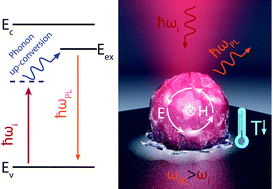Optical cooling of lead halide perovskite nanoparticles enhanced by Mie resonances†
Abstract
Halide perovskites are a family of semiconductor materials demonstrating prospective properties for optical cooling owing to efficient luminescence at room temperature and strong electron–phonon interaction. Moreover, perovskite based nanophotonic designs would allow for efficient optical cooling at the nanoscale. Here, we propose a novel strategy for the enhancement of optical cooling at the nanoscale based on optical resonance engineering in halide perovskite nanoparticles. Namely, the photoluminescence up-conversion efficiency in a nanoparticle is optimized via excitation of Mie-resonances both at emission and absorption wavelengths. The optimized theoretical photo-induced temperature decrease achieved for a hybrid halide perovskite (CH3NH3PbI3) 530 nm nanoparticle on a glass substrate is more than 100 K under CW illumination at wavelength 980 nm and moderate intensities (∼7 × 106 W cm−2). The optimized regime originates from simultaneous excitation of a magnetic quadrupole and a magnetic octupole at pump and emission wavelengths, respectively. The combination of a thermally sensitive photoluminescence signal and simplicity in the fabrication of a halide perovskite nanocavity will pave the way for implementation of nanoscale optical coolers for advanced applications.



 Please wait while we load your content...
Please wait while we load your content...